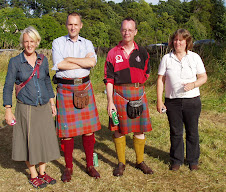Health continues to improve, and the
weekend on Loch Fyne is currently “on”. Rachel and Ed will pick
us up on their way there from London. We have arranged to communicate
by text tomorrow, as they battle their way northwards through the
holiday traffic – very 21st century.
Yesterday I re-potted my chilli plants.
Today we count pills and pack.
I think I am going to re-cast-off the
entire upper edge of my sister's shawl. At first glance, I thought it
was garter stitch, but I've had a look at the pattern and (a) it's
moss stitch, much less fun; and (b) there is a lot of adroit
short-rowing at the end, or rather long-rowing as stitches once left behind are gradually incorporated – only the last two rows involve the entire
stitch-count. So I mustn't unravel mindlessly.
Nevertheless, it should prove
relatively peaceful kitchen-table knitting. The Bridal Shawl is
distinctly anti-social.
I had a look at Liz Lovick's book. Sure
enough, she has a section called “designing with frames” but they
aren't the sort of frames I was talking about yesterday. On careful
re-reading, I think Sharon Miller's magnificent framed shawl could be
reconstructed from “Heirloom Knitting”. I wonder why she never
published it as a separate pattern? Feeling that no one would want
it, since it was already in the book? I think she's wrong, if so.
What Lovick does say, is that island
knitters almost invariably use k3togtbl for the double-decreases
which are so plaguing me. I had a go yesterday – the current motifs
have got a lot of them, and of course the surrounding trellis is
composed of nothing else. I think perhaps k3togtbl does work a bit
better in the trellis – it's easier and more secure than the centred
decreases I've been doing, and easier to retrieve in the unhappy
cases where such a decrease has to be unpicked.
In the motif, it doesn't work as well.
It all depends on how the stitches to be decreased were formed in the
preceding round. I've settled down with slip 1, k2tog, psso for
those. Both alternatives produce angled results. I was astonished
when I first learned from “Heirloom Knitting” that the angle of a
decrease doesn't matter in fine lace knitting. Lovick agrees.
Miller's instructions for the framed
shawl (such as they are), are worked centre-outwards. Lovick seems to
like to do it that way, too. Not me, if only to avoid that long
cast-on along one edge of the centre. I was feeling a bit frustrated about the resulting problem
of turning the border pattern on its head, if I insist on knitting
edging-inwards. Myrna Stahman says she includes lessons on how to do
it, in her lace tutorials.
But then it occurred to me, I know how
to do it. I've done it.
I've used Bridget Rorem's lace alphabet
several times, and at least once, I had to reverse the letters, and
did so successfully. In 2009 (I discover, by googling my own blog) I
knit a First Holy Communion veil for James' and Cathy's daughters,
incorporating the initials of both girls. It was knit from the top
down so the letters had to be reversed. Here are finished pictures of
it:
And here is an account of my
struggles with the initials. I remember that day well, when I
thought I was knitting the mirror-image of the effect I wanted.
Many border patterns wouldn't suffer
much – including the one I'm knitting at the moment – if they
were simply knit in the other direction. Not by turning the chart
upside down, which might present problems, but by fitting the
pattern as given (centre-out) into the greater abundance of initial
stitches available when knitting edging-in. If you centre the pattern
with care, it shouldn't be difficult.
I was rather struck, reading those old
blog entries, with how much earlier I used to get up, five years ago.
The current (or about-to-be-current) Economist has a 14-page pullout by James, I am told, although he has unfortunately been pushed off the front cover by the Ukraine.
The current (or about-to-be-current) Economist has a 14-page pullout by James, I am told, although he has unfortunately been pushed off the front cover by the Ukraine.






Dear Jean, I am currently knitting intarsia in the round and I'm following Anne Berk's instructions from her video tutorial published by Interweave. The system is much the same as your border: you work in rows, which are linked by yarn twists and thus appear as rounds. The tutorials are currently available at half price and could possibly be the answer to your purl-free garter in the round problems. It may be a bit late to change technique this late in the project, but maybe it's something for next time. You still have the yarn twists you get in intarsia on the wrong side, but the lace may possibly hide them. Maybe it's just another red herring... here is the link in case you want to look it up: http://bit.ly/RtplCN
ReplyDeleteThis sounds good. I'll take a look -- I'll have the iPad with me on the shores of Loch Fyne. That corner is such a mess that another mid-stream change of horse could hardly hurt.
Delete